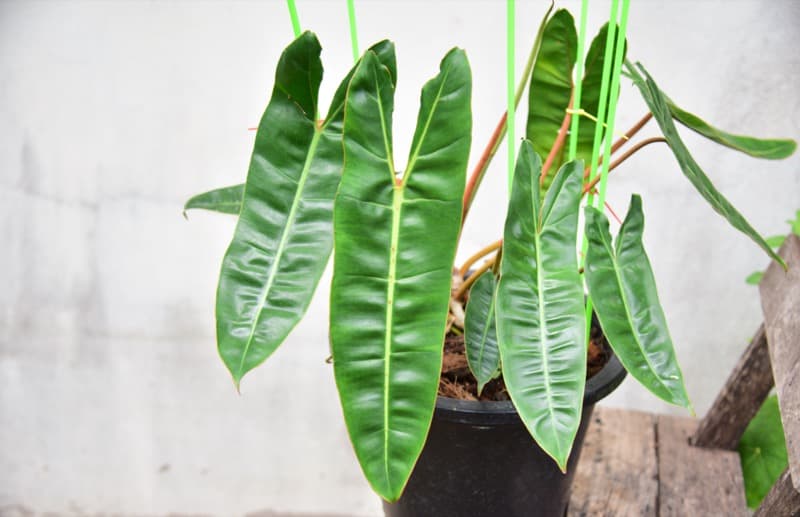The Philodendron billietiae has become a popular houseplant because it looks great and grows quickly. It also makes for a nice accent indoors or outdoors. But how do you care for it to grow healthily?
There are many types of philodendrons, and each type requires a slightly different care regimen. In this article, I’ll go over everything you need to know about caring for the philodendron billietiae.
I’ll cover everything from growing tips to watering techniques. I’ll even tell you how to repot your philodendron billietiae once it starts to get big and how to propagate the billietiae for more plants.
Philodendron billietiae Overview
A variegated vine climbing plant, the Philodendron billietiae is a wonderful choice if you are looking for a philodendron plant for a large bright space. This is an Aroid perennial vine that can grow to heights of five feet.
A member of the Araceae family, it was discovered in a tropical rainforest by Frieda Billiet in the early 1980s. It is native to Costa Rica, Brazil, and French Guiana.
This plant is ideal if you have plenty of space, especially width wise. Indoors, it will grow to five feet tall, but it needs a supporting pole. Outdoors, it can grow even taller.
It features long, gorgeous leaves on petioles that spread outward in a horizontal direction. These leaves, when mature, can measure as much as three feet in length and ten inches in width.
When the leaves are younger, they have straight edges that develop into ridged borders as they mature. Foliage is shaped much like an elephant ear with a characteristic notch in it.
The yellow-orange petioles are black-spotted and long, growing as much as one foot long. Vines will develop aerial roots to aid in supporting them as they climb.
This plant can be considered both an epiphyte and a semi-epiphyte. In nature, it may grow on both land and trees, with some plants fixing their roots firmly in the ground.
This plant can produce blooms but does so rarely. Flowers will appear as white or creamy colored flowers with spathe and spadix.

Philodendron billietiae Care Guide
The growing season for this plant is from spring through autumn. During this period, your plant will need lots of nutrients, water, and bright light. Soil beds should be allowed to dry out between waterings.
In the winter, your philodendron billietiae will enter its dormancy period, and you should interrupt feeding and water only sparingly. It can also benefit from lower light levels that allow it to rest. The ideal location will offer bright indirect light and good air ventilation.
Soil for the Philodendron billietiae
Like all philodendron plants, the billietiae like well-draining soil. The concept behind a well-draining soil type is that it won’t allow your plant to drown. Excess water will drain, while still keeping the soil moist for the roots to absorb water.
When soil beds are waterlogged, you get compacted soil and it does not allow roots to absorb oxygen for growth.
You can blend your own potting mix using equal parts of sphagnum peat moss, compost, and perlite.
Light for the Philodendron billietiae
As with most rainforest tropical plants, the philodendron billietiae needs bright indirect sunlight. In its native habitat, it will receive sunlight but partially shaded by taller plants and trees.
Never expose the billietiae to direct sunlight, as this will scorch and burn foliage. If you position this plant in an indoor setting with artificial light, such as a lobby without windows, place it off to the side of light sources, so that light does not directly hit the foliage.
A good tip is to rotate your plant once a week to make sure it receives light evenly for healthy leaves all the way around.
Water and Humidity for the Philodendron billietiae
The philodendron billietiae does best in consistently moist soil, but not in wet, soggy, or saturated soil. Overwatering will lead to root rot and potentially kill your plant.
A good rule of thumb is to check the soil bed before water to ascertain how dry it is. Stick your finger in the soil approximately to the knuckle or about two inches deep. If the soil is dry, you need to water. If a part of your finger touches moist soil, wait to water.
The philodendron billietiae prefers high humidity as a tropical plant is native to warmer temperatures.
If your home has dry air or average humidity, consider one of these methods to raise the humidity levels in the immediate area of your plant:
- Create a pebble or stone tray to place under your philodendron
- Use a humidifier for plants
- Mist your plant regularly but without soaking foliage as this can cause fungal infections.
- Group several plants together as transpiration will raise the humidity level around the plants.
Temperature for the Philodendron billietiae
The philodendron billietiae prefers a warm climate and enjoys temperatures ranging from 65° to 80° Fahrenheit during the day and 55° to 65°F at night.
It does not tolerate frost and will suffer if in cold temperatures below 55°F. If you see droopy white leaves on your billietiae, it’s freezing and in cold shock.
Fertilizer for the Philodendron billietiae
One option for fertilizing this plant is to use a balanced 10-10-10 slow-release fertilizer, three to four times a year.
If you prefer to fertilize more often, use a liquid fertilizer diluted to half-strength every two to four weeks during the growing season. Always fertilize when the soil is moist to avoid burning the root system with fertilizer in dry soil.
Pruning the Philodendron billietiae
You can either prune or pinch your philodendron billietiae to keep it healthy with an attractive appearance. If you want a bushier-looking plant, pinch off the tips of new growth when it reaches about four inches in length.
Prune your plant when you need to remove damaged, dying, or dead leaves. All dead and damaged leaves need to be removed immediately to avoid diseases spreading or fungal infection.
Repotting the Philodendron billietiae
Repot your plant every other year in a container that is a couple of inches larger than the current pot. It takes approximately two years for a root system to outgrow a pot.
If the plant becomes root bound or stressed it will become more susceptible to disease. You may notice brown spots appearing on the leaves, which indicates stress and should be addressed by repotting.
Propagating the Philodendron billietiae
The philodendron billietiae can be propagated using either stem cuttings or through air layering
How to Propagate with a Stem Cutting
- With scissors or garden shears sterilized with isopropyl alcohol, cut a stem length of approximately four inches in length below a leaf node. The cutting should have two or more leaves.
- Place your cutting to dry. Leave it for a week until the cut callouses over.
- When the cut heals, dip the cut end into growth hormone.
- Prepare a container with potting soil mix and drainage holes.
- Create a hole with your finger in the potting soil and place your cutting in the hole. Insert a moss pole for support, as the philodendron billietiae is a climber.
- Your cutting should be placed in a warm environment with bright indirect light. It will take several weeks for roots to form.
How to Propagate with Air Layering
Air Layering is a propagation method that can only be used during the growing season.
- Wound your plant with a sterilized cutting tool by creating a cut into a stem that is about two inches in depth and length.
- Place a toothpick in the wound to keep it open.
- Prepare moist sphagnum peat moss and spread it on the wound you have created. Wrap it in plastic wrap. Close the ends of the plastic with ties to increase the humidity around the wound, but not so tight as to prevent the peat moss from breathing.
- When new roots emerge, you can remove the plastic and cut just below the stem cutting with new roots.
- Transplant the new cutting with roots into a container with potting soil.
Philodendron billietiae Toxicity and Pets
Unfortunately, as a member of the Philodendron genus, it is toxic. The ASPCA (American Society for the Prevention of Cruelty to Animals) says philodendrons are toxic to pets.
The philodendron billietiae plant contains calcium oxalate crystals. These can be toxic to humans as well, so this plant should be kept away from small children.
Calcium oxalate crystals cause swelling, burning, nausea diarrhea, and respiratory problems. The sap is irritating to the skin and can cause an allergic reaction. Ingestion can contribute to causing kidney failure in pets.
Symptoms of poisoning to watch for include:
- Lost appetite
- Diarrhea
- Swelling lips, mouth, and tongue
- Nausea
- Mouth sores
- Vomiting
- Pawing at the face
- Swallowing problems
- Drooling
You can attempt to rinse out the mouth of your pet if it chewed this plant to relieve symptoms. The skin should also be washed and rinsed after contact with the plant’s sap.
Contact your veterinarian in the event of severe symptoms or go to an animal emergency care facility.
Philodendron billietiae Pests, Diseases, and Problems
Philodendron billietiae Pests
This particular philodendron does not attract a lot of pests, fortunately. But this doesn’t mean that it is immune to pest infestations.
If you purchase at nurseries or garden centers, check the plants for any insect infestation or plant diseases before bringing them home.
The most common pests to be on the lookout for are:
Mealybugs – These pests are immediately apparent because they look like deposits of cotton on the plant. They are sap suckers and will deplete a plant when they take up residence.
If you have a mealybug infestation, remove what pests you can manually and then treat your plant with diluted organic neem oil.
Aphids – When new growth is stunted or damaged, your plant could have aphids. These are tiny pear-shaped bugs with antennae, but are barely visible to the naked eye. They can do a lot of damage as they are sap suckers and feed off the lymph of the plant.
Insecticidal soap will resolve any aphid problems.
Philodendron billietiae Diseases
The largest risks for your philodendron billietiae include bacterial infections, fungal infections, and root rot. Overwatering is usually the reason for these illnesses.
Remove all infected plant parts such as leaves, stems, and roots. Wash the remaining healthy roots and treat them with fungicide afterward.
Repot your plant in a fresh growing medium. Wait several days before watering.
Droopy White Leaves
This indicates cold shock. Move your plant to a warm location and away from cold drafts like windows, doorways, hallways, and heating or air conditioning units and vents.
V-Shaped Stains on Leaf Tips
These v-shaped stains indicate the billietiae is suffering from a magnesium deficiency. Spray your plant immediately with a mix of Epsom salts and water, or apply a fertilizer with a concentration of magnesium.
Leaf Tips Curling
If your leaf tips are curling, this generally indicates over-fertilization. Change your plant’s soil mix by repotting and use less fertilizer. Be careful of fertilizing too much. Remember to dilute any liquid fertilizers with water.
Philodendron billietiae Final Thoughts
The Philodendron billietiae is easy to grow and maintain. If you keep them well watered, their foliage will stay variegated.
When looking for a large plant with variegated leaves, the Philodendron billietiae should definitely be considered.
Long impressive foliage featuring patches of variegation adds to its appeal. But to maintain the variegated variety, bright indirect light is necessary to maintain the unique variegation.
For other philodendron plants, check out these care guides:
Philodendron billietiae FAQs
Does Philodendron Billietiae climb?
Yes, the Philodendron Billietiae does climb! They can grow up to 3 feet tall with beautiful variegated leaves. They love to climb poles, bamboo sticks and mossy poles. The Billietiae is grown and used to decorate homes, offices, and public buildings.
Is Philodendron Billietiae easy to grow?
Yes, the Philodendron Billietiae is very easy to grow. They prefer bright indirect light, warm temperatures, and high humidity like their natural habitat. They are also known as “air plants” because they absorb their own weight in air. They are also known to be hardy and long lived.
Why are variegated Philodendron Billietiae so expensive?
The variegated Philodendron Billietiae is expensive because it’s rare and in low supply. The Billietiae variety is in high demand for their unique leaves and coloration. More mature plants take longer to care for and are harder to ship, so they will also cost more than younger plants.

